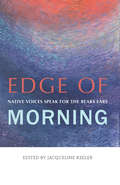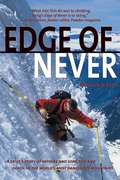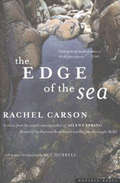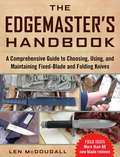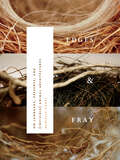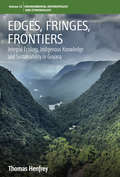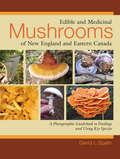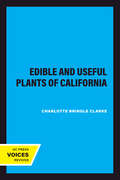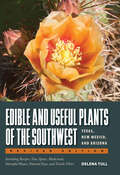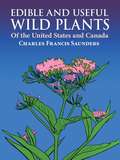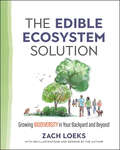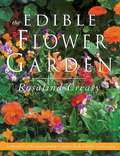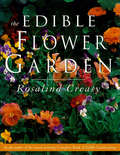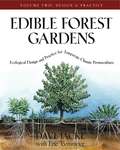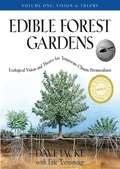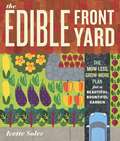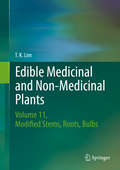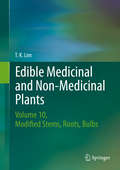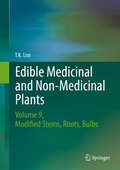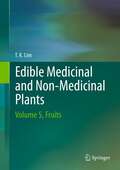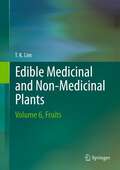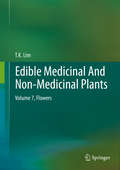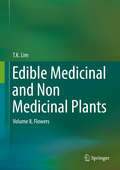- Table View
- List View
Edge of Morning: Native Voices Speak for the Bears Ears
by Jacqueline KeelerIn support of tribal efforts to protect the Bears Ears, Native writers bear testimony to the fragile and essential nature of this sacred landscape in America’s remote red rock country. Through poem and essay, these often-ignored voices explore the ways many native people derive tradition, sustenance, and cultural history from the Bears Ears.
The Edge of Never: A Skier's Story of Life, Death, and Dreams in the World's Most Dangerous Mountains
by William A. KerigIn the world of big-mountain skiing, Trevor Petersen was a legend. Appearing in countless films, magazines and photo shoots, his ponytail flying behind him, he was the very embodiment of the freewheeling spirit of extreme skiing in the 1980s and early '90s. Then it all came to an end. On February 26, 1996, while skiing in Chamonix, France - the so-called Death Sport Capital of the World - an avalanche swept Trevor away. His body was found sitting up in the snow as if gazing at the mountains he loved. Nearly a decade later, Trevor's fifteen-year-old son, Kye Petersen, a rising star in his own right, traveled to Chamonix to ski the run that took his father's life and, with the aid of some of the world's greatest ski mountaineers, to become a member of skiing's big-mountain tribe. There to chronicle Kye's story was William A. Kerig, a filmmaker with a dream of his own - to create a film about the soul of big-mountain skiing and the band of mountaineers who ski the steepest, wildest, most dangerous terrain in the world. In The Edge of Never, Kerig gives us not only a ripping adventure tale about a young man coming of age but a frank and subtle portrait of the extreme skiers who "live big" in the face of death and risk everything to experience the fullness of life in the mountains.
The Edge of the Sea: Under The Sea-wind / The Sea Around Us / The Edge Of The Sea
by Rachel CarsonFrom the National Book Award–winning author of Silent Spring: An exploration of marine life that takes us into &“a truly extraordinary world&” (The Atlantic Monthly). Known for &“catching the life breath of science on the still glass of poetry,&” nature writer and marine biologist Rachel Carson is an icon of environmentalism, and her first love was the sea (Time). In this book, she explores rocky shores, sandy beaches, and coral reefs, leading us into unknown worlds to catch the evanescent beauty of a tide pool and tell the story of a grain of sand, and conveys the true complexity, beauty, and wonder of marine life, both animals and plants. With an introduction by Sue Hubbell, author of A Country Year, and illustrations by Bob Hines, The Edge of the Sea serves as both a field guide and a pleasurable, enlightening read. &“It is a truly extraordinary world which Miss Carson vividly unfolds to us . . . a world full of marvels such as the tiny periwinkle, which has 3,500 teeth, and the sea pansy, which has responded to the struggle for survival by turning itself from an individual into a colony.&” —The Atlantic Monthly
The Edgemaster's Handbook: A Comprehensive Guide to Choosing, Using, and Maintaining Fixed-Blade and Folding Knives
by Len McDougallDo you feel a soul-deep connection with knives and tools that are engineered to cut through other materials? Does having a sturdy knife on your person imbue you with a profound, but somehow unidentifiable, sense of security? The Edgemaster’s Handbook is just that: a book completely dedicated to the care and usage of knives. Whether handling a dagger, stiletto, or bolo, you’ll learn the knife’s purpose and how to use is properly while keeping the blade clean and yourself safe. Len McDougall has spent his entire life—almost sixty years—learning the nuts and bolts of staying alive under adverse conditions and the mastery of weapons. And now more than ever we will need to take his lessons seriously, as understanding what to expect and how to adapt will increase the odds for survival. Featuring methods that have been personally tested through hard, field-proven experiences, you will learn everything needed to use knives for both outdoor living and protection. Included in this book are many lessons on knives, including: Sharpening a blade How to properly identify different types Collecting Using for survival and self-defense And so much more Whether for the collector or the outdoorsman, McDougall shares all his knowledge and understanding of this tool for you to understand and better appreciate. The Edgemaster’s Handbook is just that; a collection of tips, tricks, lessons, and knowledge from a professional that will make sure you master the usage of knives in your daily life.
Edges & Fray: on language, presence, and (invisible) animal architectures (Wesleyan Poetry Ser.)
by Danielle VogelPoetry, prose, and photographs, explore the edges of languageEdges & Fray is an embodied meditation that cultivates receptivity and deep listening to the ways we inhabit language and its ethereal resilience. Combining close observation of birds' nests and the writing process, Danielle Vogel brings the reader into communion with language as a mode of presence. The frayed edges of consciousness are carefully arranged to suggest how writing, and the book, can serve as a site of radical transformation. Experimental and deeply grounded, this work is lyrical and patient. The text creates overlapping ecological fields, wherein each field is a system always in a state of becoming. Finding its strength in fragility, Edges & Fray is personal without feeling private, experimental without feeling programmatic. Its construction is intuitive and masterful, its many threads interwoven and intrinsically linked. This is a beautiful and inspiring book at the intersection of poetry, somatics, ecology, and divination.
Edges, Fringes, Frontiers: Integral Ecology, Indigenous Knowledge and Sustainability in Guyana (Environmental Anthropology and Ethnobiology #23)
by Thomas HenfreyBased on an ethnographic account of subsistence use of Amazonian forests by Wapishana people in Guyana, Edges, Frontiers, Fringes examines the social, cultural and behavioral bases for sustainability and resilience in indigenous resource use. Developing an original framework for holistic analysis, it demonstrates that flexible interplay among multiple modes of environmental understanding and decision-making allows the Wapishana to navigate social-ecological complexity successfully in ways that reconcile short-term material needs with long-term maintenance and enhancement of the resource base.
An Edible Alphabet
by Bonnie ChristensenEach page shows a letter of the alphabet in capital and small, a picture with the name of a plant, and pictures showing how the plant is used. A multi-cultural, multi-generational cast of characters makes this an unusual alphabet.
Edible and Medicinal Mushrooms of New England and Eastern Canada: A Photographic Guidebook to Finding and Using Key Species
by David L. SpahrThis beautifully illustrated guidebook provides specific, easy-to-understand information on finding, collecting, identifying, and preparing the safer and more common edible and medicinal mushroom species of New England and Eastern Canada. Author David Spahr, a trained commercial photographer, here combines his mycological expertise and photographic skill to produce an attractive and detailed overview of his subject. Based on decades of practical experience and research, the book is written in a clear and forthright style that avoids the dry, generic descriptions of most field guides. Edible and Medicinal Mushrooms of New England and Eastern Canada also provides useful ideas for cooking mushrooms. Rather than simply providing recipes, the book discusses the cooking characteristics of each variety, with advice about matching species with appropriate foods. Many mushrooms contain unique medicinal components for boosting the immune system to fight cancer, HIV, and other diseases, and Spahr offers practical and prudent guidelines for exploration of this rapidly emerging area of alternative therapeutic practice.
Edible and Useful Plants of California (California Natural History Guides #41)
by Charlotte Bringle ClarkeBoth American Indians and the pioneers knew and used many different plant species-for food, fibers, medicine, tools, and other purposes. This unique book is a guide to identifying more than 220 such plants. But it goes much further-it also tells the reader how to prepare, cook, and otherwise use them. Some of the dishes for which recipes are given have won culinary prizes. All have been tested not only by the author but also by her students and by journalists-who have been uniformity surprised and impressed.The plants are organized by habitat communities. Description, photos, drawings, and distribution information are given. Where poisonous look-alikes exist, they too are illustrated. Much fascinating information about Indian uses of native and introduced species is included. The author emphasizes conservation considerations; the aim of the book is to educate the reader about intriguing uses of the plants, and to tell how to gather and use the most palatable and abundant species without damaging the environment.
Edible and Useful Plants of the Southwest: Texas, New Mexico, and Arizona
by Delena TullA guide to useful Southwestern wild plants, including recipes, teas, spices, dyes, medicinal uses, poisonous plants, fibers, basketry, and industrial uses.All around us there are wild plants useful for food, medicine, and clothing, but most of us don&’t know how to identify or use them. Delena Tull amply supplies that knowledge in this book, which she has now expanded to more thoroughly address plants found in New Mexico and Arizona, as well as Texas.Extensively illustrated with black-and-white drawings and color photos, this book includes the following special features:· Recipes for foods made from edible wild plants· Wild teas and spices· Wild plant dyes, with instructions for preparing the plants and dying wool, cotton, and other materials· Instructions for preparing fibers for use in making baskets, textiles, and paper· Information on wild plants used for making rubber, wax, oil, and soap· Information on medicinal uses of plants· Details on hay fever plants and plants that cause rashes· Instructions for distinguishing edible from poisonous berries Detailed information on poisonous plants, including poison ivy, oak, and sumac, as well as herbal treatments for their rashes
Edible and Useful Plants of the Southwest: Texas, New Mexico, and Arizona
by Delena TullAll around us there are wild plants useful for food, medicine, and clothing, but most of us don't know how to identify or use them. Delena Tull amply supplies that knowledge in this book, which she has now expanded to more thoroughly address plants found in New Mexico and Arizona, as well as Texas. Extensively illustrated with black-and-white drawings and color photos, this book includes the following special features:- Recipes for foods made from edible wild plants- Wild teas and spices- Wild plant dyes, with instructions for preparing the plants and dying wool, cotton, and other materials- Instructions for preparing fibers for use in making baskets, textiles, and paper- Information on wild plants used for making rubber, wax, oil, and soap- Information on medicinal uses of plants- Details on hay fever plants and plants that cause rashes- Instructions for distinguishing edible from poisonous berries- Detailed information on poisonous plants, including poison ivy, oak, and sumac, as well as herbal treatments for their rashes
Edible and Useful Wild Plants of the United States and Canada
by Charles F. SaundersThis work discusses beverage plants, vegetable substitutes for soap, medicinal plants, and those that can be used as fibers, dyes, smoking material, adhesives, and candles. A final chapter describes a variety of poisonous plants. "Secure a copy of this very enlightening book. In fact, if you travel, it should be a constant companion." -- St. Petersburg Independent. 94 illustrations.
The Edible Ecosystem Solution: Growing Biodiversity in Your Backyard and Beyond
by Zach LoeksStart a peaceful revolution by planting an edible ecosystem and sharing the experience with your neighborsHumans have always thrived in rich, diverse, edible ecosystems. Yet most cities and suburbs are blanketed by lawns, ornamentals, and a lack of biodiversity, let alone anything edible. It is within these sterile landscapes that seeds of an edible ecosystem lie.The Edible Ecosystem Solution is a comprehensive, practical guidebook that looks at underutilized spaces to reveal the many opportunities for landscape transformation that are both far-reaching and immediately beneficial and enjoyable. Contents include:Hundreds of full-color infographics, illustrations, and photographs that clearly outline the principles and concepts of edible landscape design and benefitsHow to get started with as little as 25 square feet of landHow to transition a garden plot into a place of edible abundance and an edible biodiversity hot spot, living laboratory, and a source point for transitioning and transforming community and cultureChoosing appropriate plants for insects, wildlife, and food productionScaling up and networking backyard edible ecosystems at the neighborhood level and beyond to build community food security and resilience.The Edible Ecosystem Solution is for everyone with access to a bit of yard, a desire for food security, biodiversity, and a beautiful and resilient community, and for anyone who wants to reclaim humanity's place in a rich, abundant, edible ecosystem.
The Edible Flower Garden
by Rosalind CreasyA comprehensive guide to selecting and growing flowers that can be used for cookery, both as garnishes and as ingredients.
The Edible Flower Garden
by Rosalind CreasyThe Edible Flower Garden is a beautiful collection of flowers that can be used for cookery: from candied violets and roses to decorate appetizers and cakes, to nasturtiums for a colorful shrimp salad, to day lily buds, pink clover, and wild mustard flowers that are tossed together in a spectacular stir-fry.
Edible Forest Gardens: Ecological Design And Practice For Temperate Climate Permaculture (Volume #2)
by Dave Jacke Eric ToensmeierIn Volume II, Dave Jacke and Eric Toensmeier move on to practical considerations: concrete ways to design, establish, and maintain your own forest garden. Along the way they present case studies and examples, as well as tables, illustrations, and a uniquely valuable "plant matrix" that lists hundreds of the best edible and useful species.
Edible Forest Gardens: Ecological Vision And Theory For Temperate Climate Permaculture Volume 1
by Dave Jacke Eric ToensmeierEdible Forest Gardens is a groundbreaking two-volume work that spells out and explores the key concepts of forest ecology and applies them to the needs of natural gardeners in temperate climates. Volume I lays out the vision of the forest garden and explains the basic ecological principles that make it work.
The Edible Front Yard: The Mow-Less, Grow-More Plan for a Beautiful, Bountiful Garden
by Ivette Soler“Front lawns, beware: The Germinatrix has you in her crosshairs! Ivette Soler is a welcome voice urging us to mow less and grow some food—in her uniquely fun, infectious yet informative way.” —Garden RantPeople everywhere are turning patches of soil into bountiful vegetable gardens, and each spring a new crop of beginners pick up trowels and plant seeds for the first time. They're planting tomatoes in raised beds, runner beans in small plots, and strawberries in containers. But there is one place that has, until now, been woefully neglected—the front yard. And there's good reason. The typical veggie garden, with its raised beds and plots, is not the most attractive type of garden, and favorite edible plants like tomatoes and cucumbers have a tendency to look a scraggily, even in their prime. But The Edible Front Yard isn't about the typical veggie garden, and author Ivette Soler is passionate about putting edibles up front and creating edible gardens with curb appeal. Soler offers step-by-step instructions for converting all or part of a lawn into an edible paradise; specific guidelines for selecting and planting the most attractive edible plants; and design advice and plans for the best placement and for combining edibles with ornamentals in pleasing ways. Inspiring and accessible, The Edible Front Yard is a one-stop resource for a front-and-center edible garden that is both beautiful and bountiful year-round.
Edible Medicinal and Non-Medicinal Plants: Volume 11 Modified Stems, Roots, Bulbs
by T. K. LimThis book covers such plants with edible modified storage subterranean stems (corms, rhizomes, stem tubers) and unmodified subterranean stem stolons, above ground swollen stems and hypocotyls, storage roots (tap root, lateral roots, root tubers), and bulbs, that are eaten as conventional or functional food as vegetables and spices, as herbal teas, and may provide a source of food additive or neutraceuticals. This volume covers selected plant species with edible modified stems, roots and bulbs in the families Iridaceae, Lamiaceae, Marantaceae, Nelumbonaceae, Nyctaginaceae, Nymphaeaceae, Orchidaceae, Oxalidaceae, Piperaceae, Poaceae, Rubiaceae and Simaroubaceae. The edible species dealt with in this work include wild and underutilized crops and also common and widely grown ornamentals.To help in identification of the plant and edible parts coloured illustrations are included.<P><P> As in the preceding ten volumes, topics covered include: taxonomy (botanical name and synonyms); common English and vernacular names; origin and distribution; agro-ecological requirements; edible plant parts and uses; plant botany; nutritive, medicinal and pharmacological properties with up-to-date research findings; traditional medicinal uses; other non-edible uses; and selected/cited references for further reading. This volume has separate indices for scientific and common names; and separate scientific and medical glossaries.
Edible Medicinal and Non-Medicinal Plants: Volume 10, Modified Stems, Roots, Bulbs
by T. K. LimVolume 10 is part of a multi compendium Edible Medicinal and Non-Medicinal Plants. This work is of significant interest to medical practitioners, pharmacologists, ethnobotanists, horticulturists, food nutritionists, botanists, agriculturists, conservationists and general public. 59 plant species with edible modified stems, roots and bulbs in the families Amaranthaceae, Cannaceae, Cibotiaceae, Convolvulaceae, Cyperaceae, Dioscoreaceae, Euphorbiaceae, Fabaceae, Iridaceae, Lamiaceae, Marantaceae, Nelumbonaceae, Nyctaginaceae, Nymphaeaceae, Orchidaceae, Oxalidaceae, Piperaceae, Poaceae, Rubiaceae, Simaroubaceae, Solanaceae, Tropaeolaceae, Typhaceae and Zingiberaceae. Topics covered include: taxonomy; common/ vernacular names; origin/ distribution; agroecology; edible plant parts/uses; botany; nutritive/medicinal properties, nonedible uses and selected references.
Edible Medicinal and Non Medicinal Plants: Volume 9, Modified Stems, Roots, Bulbs
by T. K. LimVolume 9 is part of a multicompendium Edible Medicinal and Non-Medicinal Plants, on plants with edible modified stems, roots and bulbs from Acanthaceae to Zygophyllaceae (tabular) and 32 selected species in Alismataceae, Amaryllidaceae, Apiaceae, Araceae, Araliaceae, Asparagaceae, Asteraceae, Basellaceae, Brassicaceae and Campanulaceae in detail. This work is of significant interest to medical practitioners, pharmacologists, ethnobotanists, horticulturists, food nutritionists, botanists, agriculturists, conservationists, and general public. Topics covered include: taxonomy; common/ vernacular names; origin/ distribution; agroecology; edible plant parts/uses; botany; nutritive/medicinal properties, nonedible uses and selected references.
Edible Medicinal And Non-Medicinal Plants: Volume 5, Fruits
by T. K. LimThis book continues as volume 5 of a multicompendium on Edible Medicinal and Non-Medicinal Plants. It covers edible fruits/seeds used fresh, cooked or processed as vegetables, cereals, spices, stimulant, edible oils and beverages. It covers selected species from the following families: Apiaceae, Brassicaceae, Chenopodiaceae, Cunoniaceae, Lythraceae, Papaveraceae, Poaceae, Polygalaceae, Polygonaceae, Proteaceae, Ranunculaceae, Rhamnaceae, Rubiaceae, Salicaceae, Santalaceae, Xanthorrhoeaceae and Zingiberaceae. This work will be of significant interest to scientists, medical practitioners, pharmacologists, ethnobotanists, horticulturists, food nutritionists, botanists, agriculturists, conservationists, lecturers, students and the general public. Topics covered include: taxonomy; common/English and vernacular names; origin and distribution; agroecology; edible plant parts and uses; botany; nutritive/pharmacological properties, medicinal uses, nonedible uses; and selected references.
Edible Medicinal And Non-Medicinal Plants: Volume 6, Fruits
by T. K. LimThis book continues as volume 6 of a multi-compendium on Edible Medicinal and Non-Medicinal Plants. It covers edible fruits/seeds used fresh, cooked or processed into other by-products, or as vegetables, cereals, spices, stimulant, edible oils and beverages. It covers selected species from the following families: Sapindaceae, Sapotaceae, Schisandraceae, Solanaceae, Thymelaeaceae, Urticaceae, Vitaceae and Winteraceae. This work will be of significant interest to scientists, researchers, medical practitioners, pharmacologists, ethnobotanists, horticulturists, food nutritionists, agriculturists, botanists, conservationists, lecturers, students and the general public. Topics covered include: taxonomy; common/English and vernacular names; origin and distribution; agroecology; edible plant parts and uses; botany; nutritive and pharmacological properties, medicinal uses and research findings; nonedible uses; and selected references.
Edible Medicinal And Non-Medicinal Plants: Volume 7, Flowers
by T. K. LimThis book continues as volume 7 of a multi-compendium on Edible Medicinal and Non-Medicinal Plants. It covers plant species with edible flowers from families Acanthaceae to Facaceae in a tabular form and seventy five selected species from Amaryllidaceae, Apocynaceae, Asclepiadaceae, Asparagaceae, Asteraceae, Balsaminaceae, Begoniaceae, Bignoniaceae, Brassicaceae, Cactaceae, Calophyllaceae, Caprifoliaceae, Caryophyllaceae, Combretaceae, Convolvulaceae, Costaceae, Doryanthaceae and Fabaceae in detail. This work will be of significant interest to scientists, medical practitioners, pharmacologists, ethnobotanists, horticulturists, food nutritionists, botanists, agriculturists, conservationists, lecturers, students and the general public. Topics covered include: taxonomy; common/English and vernacular names; origin and distribution; agroecology; edible plant parts and uses; botany; nutritive/pharmacological properties, medicinal uses, nonedible uses; and selected references.
Edible Medicinal and Non Medicinal Plants: Volume 8, Flowers
by T. K. LimVolume 8 is part of a multicompendium Edible Medicinal and Non-Medicinal Plants, on plants with edible flowers from Geraniaceae to Zingiberaceae (tabular) and 82 species in Geraniaceae, Iridaceae, Lamiaceae, Liliaceae, Limnocharitaceae, Magnoliaceae, Malvaceae, Meliaceae, Myrtaceae, Nyctaginaceae, Nymphaeaceae, Oleaceae, Onagraceae, Orchidaceae, Paeoniaceae, Papaveraceae, Plantaginaceae, Poaceae, Polygonaceae, Primulaceae, Proteaceae, Ranunculaceae, Rosaceae, Rubiaceae, Rutaceae, Solanaceae, Theaceae, Tropaeolaceae, Tyhpaceae, Violaceae, Xanthorrhoeaceae and Zingiberaceae in detail. This work is of significant interest to medical practitioners, pharmacologists, ethnobotanists, horticulturists, food nutritionists, botanists, agriculturists, conservationists and general public. Topics covered include: taxonomy; common/ vernacular names; origin/ distribution; agroecology; edible plant parts/uses; botany; nutritive/medicinal properties, nonedible uses and selected references.
